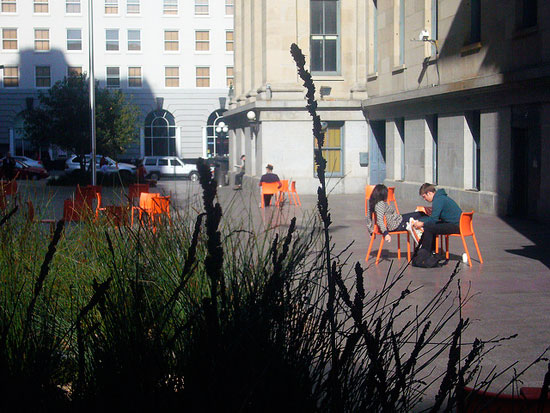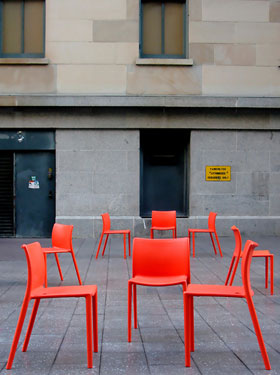
In its annual Smart Growth awards ceremony, the Environmental Protection Agency awarded San Francisco's Mint Plaza with its "Civic Spaces" prize, honoring the City and County of San Francisco, as well as developers and architects that transformed the former Jesse Street alley into a busy public realm. The award was announced yesterday in Washington DC, in coordination with the EPAs 40th anniversary festivities, where San Francisco joined New York City and Portland among others receiving commendations.
Mint Plaza was the result of a public-private partnership that used private funding to build a public plaza owned by the city, with relatively little city investment. According to the EPA's announcement, the project cost $3.2 million to build, of which only $150,000 came from public funds. The balance was raised by Martin Building Company, which created a Community Facilities District (much like a Community Benefit District), levying a 30-year special property tax on certain buildings around the plaza to leverage tax exempt bonds. Martin also established Friends of Mint Plaza, a non-profit organization that raises funds to manage ongoing maintenance and programming at the plaza.
Jason Elliott, policy adviser to Mayor Gavin Newsom, said the EPA award was an honor and said Mint Plaza "represents people taking affirmative ownership in their micro neighborhoods."
"This is a community coming together to invest in their own public realm," said Elliott, who highlighted the trial traffic diversions on Market Street and said they can complement destinations in the neighborhood. Without creating destinations like Mint Plaza, he said, the public would have nowhere to bike and walk to, neighborhoods would not be revitalized. "We can do a lot of the things we think we're good at, but when we have the private sector step up and take the proactive responsibility for reinvigorating their own communities," it expands on what the city can accomplish.

"As a resident, Mint Plaza functions as our urban ‘front yard’ and provides a safe and nurturing environment for my son and his friends. As such, the plaza has already created a unique sense of public space ownership in a sometimes impersonal downtown," William Duncanson, a Mint Plaza neighborhood resident, said in the EPA's release. "Residents view the plaza as a place for living rather than merely a public park or a conduit to get from here to there."
In honoring the city and the private representatives, the EPA characterized the space as a "public living room," noting the transformation of the alley into an 18,000 square foot plaza had attracted new private investment into the surrounding neighborhoods, including four restaurants and cafes.
Joining officials from San Francisco at the awards ceremony in Washington D.C. was Scott Catafa, a principal at CMG Architects, who designed the plaza. "I think it's a great example for the city for how these things can work for a public-private partnership to maintain public spaces and improve them," he said.
Catafa said there were great limitations on the design of the plaza because of the intricate public utilities underneath the former alley, which prevented them from adding as many trees as they wanted. Catafa said Bryant Park in New York City was an inspiration for the movable furniture and some of the design elements, and described the arbor in the plaza as a way to provide greenery in place of additional trees.
Noting that the space had previously been used for parking tour buses, Catafa said that the openness of the plaza contributed to the feeling of increased safety. Referring to the "eyes on the street" effect that Jane Jacobs wrote about in her iconic The Death and Life of Great American Cities, Catafa said the space worked to change people's impressions of an area of the city with a previously bad reputation for drug dealing.
Saying that maintenance of the space was equally or more important than the design, Catafa said Mint Plaza would be a model for other projects in San Francisco and beyond. "It's about a perception too because people take care of spaces that seem to be maintained."





